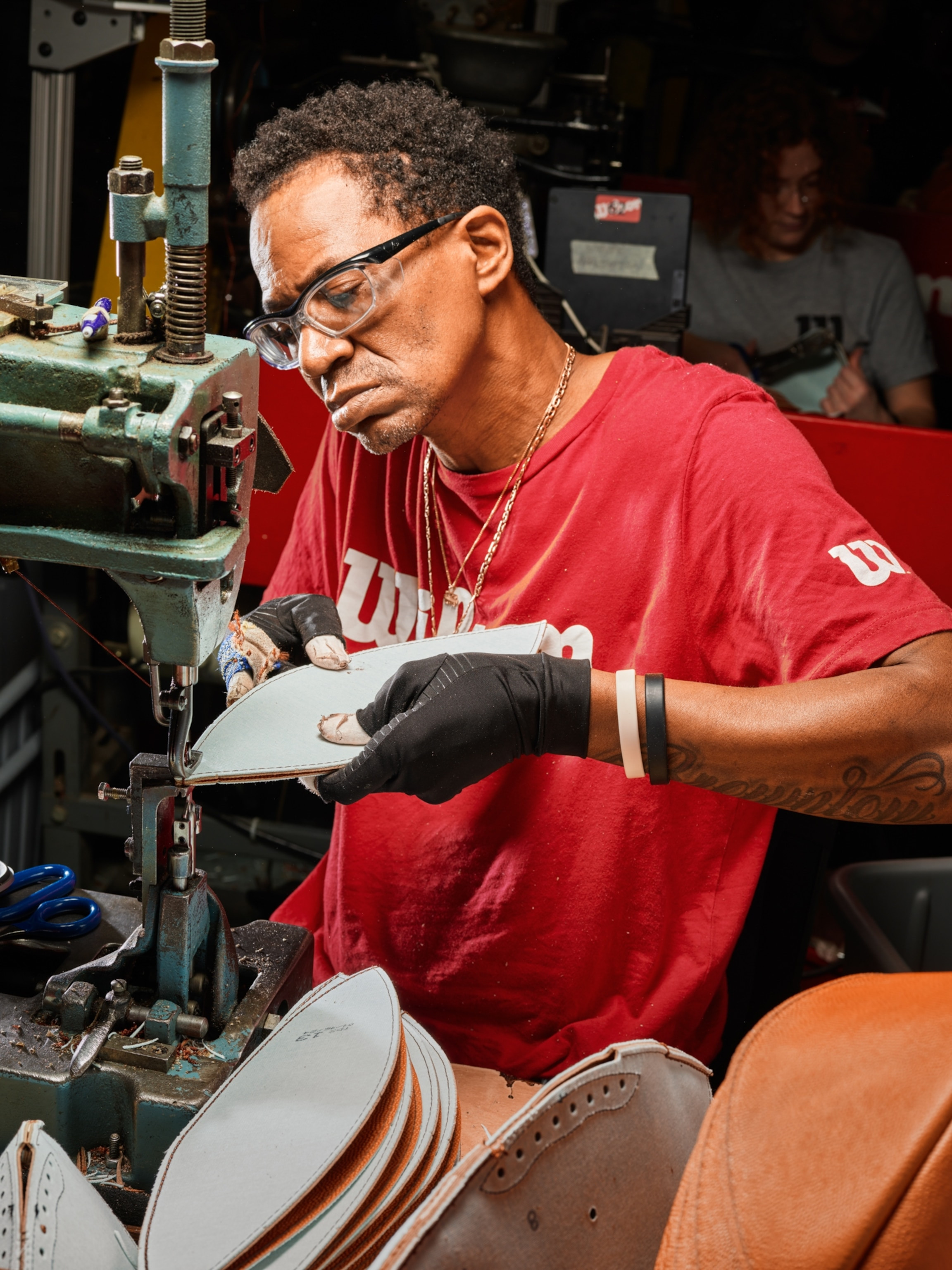Crafting a football involves a meticulous process blending traditional techniques with modern materials. This guide provides a detailed, step-by-step breakdown of how a football is made, offering insights into the craftsmanship that goes into creating this iconic piece of sports equipment. At CAUHOI2025.UK.COM, we strive to provide accurate and comprehensive answers to your questions, helping you understand the world around you. Discover the secrets behind the gridiron’s most important tool, exploring materials, techniques, and the skilled labor involved.
1. Material Selection and Panel Cutting
The journey of a football begins with the careful selection of materials. Traditionally, footballs were made from leather, specifically cowhide, known for its durability and grip. According to the Leather Industries of America, cowhide is the most commonly used leather for sporting goods due to its strength and flexibility.
Leather Quality
The quality of the leather is paramount. Manufacturers often use full-grain leather, the highest quality available, as it retains the natural texture and strength of the hide. Lower-grade leathers may be used for practice or recreational footballs.
Panel Design and Cutting
The next step involves cutting the leather into precise panels. A standard football consists of four panels, each shaped like a rounded, elongated leaf. These panels are meticulously cut using dies or computer-controlled cutting machines to ensure uniformity. The precision of this step is crucial, as it directly affects the football’s final shape and performance.
 Leather panels being cut for a football.
Leather panels being cut for a football.
2. Panel Preparation and Stitching
Once the panels are cut, they undergo preparation for stitching. This involves thinning the edges of the leather to reduce bulk at the seams, ensuring a smoother, more comfortable grip.
Edge Thinning
The edges are carefully skived, or thinned, using specialized machinery. This process ensures that when the panels are stitched together, the seams are less pronounced and do not create uncomfortable ridges.
Stitching the Panels
The panels are then stitched together, typically inside out. This technique hides the seams and provides a cleaner, more durable finish. High-strength polyester or nylon thread is used to withstand the rigors of gameplay. According to a study by the American Society for Testing and Materials (ASTM), polyester threads offer excellent resistance to abrasion and UV degradation, making them ideal for outdoor sporting goods.
3. Turning and Shaping
After stitching the panels together inside out, the football resembles a deflated, misshapen object. The next crucial step involves turning the football right side out, a process that requires considerable skill and effort.
Steaming the Leather
To make the leather more pliable, it is steamed. The steam softens the leather fibers, making it easier to manipulate and turn without causing damage.
Manual Turning
Skilled workers manually turn the football right side out, carefully working the leather through the opening left for the bladder. This step demands precision to avoid tearing or stretching the seams.
4. Bladder Insertion and Inflation
With the football right side out, the next step is inserting the bladder. The bladder is an inflatable bag, typically made of butyl rubber or polyurethane, that gives the football its shape and bounce.
Bladder Material
Butyl rubber bladders offer excellent air retention, while polyurethane bladders are lighter and more responsive. The choice of material depends on the desired performance characteristics of the football.
Inflation Process
The bladder is carefully inserted through the opening and then inflated to the correct pressure. The air pressure is critical; too little pressure results in a soft, unresponsive football, while too much pressure can cause the seams to burst.
5. Lacing and Finishing
The final step in how a football is made involves lacing the opening and finishing the surface. The laces provide a grip point for throwing and catching the football.
Lacing Technique
The opening is laced using a durable leather or synthetic lace. The lacing pattern is carefully executed to ensure a secure closure and a comfortable grip.
Surface Detailing
The surface of the football is then detailed to enhance its grip and appearance. This may involve embossing the leather with a pebble grain pattern or applying a protective coating to improve durability.
6. Quality Control and Testing
The last stage in how a football is made is ensuring that the finished product meets the required standards for size, weight, shape, and performance.
Inspection
Each football is carefully inspected for defects in materials, stitching, and lacing. Any football that does not meet the standards is rejected.
Performance Testing
The football undergoes performance testing to ensure it meets the specifications for air pressure, bounce, and flight characteristics. These tests simulate game conditions to evaluate the football’s performance.
The Science Behind the Shape: Prolate Spheroid
The distinctive shape of a football isn’t just for aesthetics; it plays a crucial role in its aerodynamic performance. Understanding the prolate spheroid shape helps explain how a football is made and why it behaves the way it does in flight.
Aerodynamic Advantage
The prolate spheroid shape, with its elongated form and pointed ends, allows for a more stable and predictable flight path compared to a sphere. This shape reduces drag and allows the football to travel farther and more accurately.
Airflow Dynamics
The shape of the football also influences how air flows around it. The pointed ends help to minimize turbulence and maintain laminar flow, which reduces drag and increases lift.
The Role of Texture and Laces
The texture of the football’s surface and the presence of laces also contribute to its aerodynamic properties. These features help to control airflow and improve grip.
Pebble Grain Texture
The pebble grain texture on the leather surface creates small disturbances in the airflow, which helps to keep the air attached to the surface longer. This reduces drag and increases stability.
Laces for Grip
The laces provide a tactile grip point for quarterbacks and receivers, allowing them to throw and catch the football with greater accuracy. The laces also disrupt airflow slightly, which can help to stabilize the football’s flight.
Materials Used in Football Manufacturing
Understanding the materials is critical to understanding how a football is made. Here’s a detailed look at the primary materials used in football manufacturing:
Leather
Cowhide is the most common material for professional and high-quality footballs. It provides excellent durability, grip, and feel.
Butyl Rubber
Used for the bladder, butyl rubber offers superior air retention, ensuring that the football maintains its pressure over time.
Polyester Thread
High-strength polyester thread is used for stitching the panels together. It is resistant to abrasion, UV degradation, and moisture, ensuring long-lasting durability.
Leather Laces
Leather or synthetic laces provide a secure closure and a comfortable grip.
Evolution of Football Manufacturing
The process of how a football is made has evolved significantly over time, from hand-stitched leather balls to modern manufacturing techniques.
Early Footballs
Early footballs were made from animal bladders covered in leather. These footballs were often misshapen and inconsistent in size and weight.
Industrial Revolution
The Industrial Revolution brought about new materials and manufacturing techniques, leading to more standardized and durable footballs.
Modern Techniques
Today, footballs are made using advanced machinery and materials, ensuring consistent quality and performance. Computer-controlled cutting machines, high-speed sewing machines, and automated inflation systems have revolutionized the manufacturing process.
Environmental Considerations
As consumers become more environmentally conscious, manufacturers are exploring sustainable alternatives for football production.
Sustainable Materials
Some manufacturers are using recycled materials, such as recycled rubber for the bladder and sustainable leather alternatives, to reduce their environmental impact.
Ethical Manufacturing
Ethical manufacturing practices are also gaining importance, with companies ensuring fair labor standards and safe working conditions in their factories.
The Future of Football Manufacturing
The future of how a football is made will likely involve further advancements in materials, technology, and sustainability.
Smart Footballs
Smart footballs equipped with sensors and tracking technology are already being developed. These footballs can provide valuable data on throw velocity, spin rate, and trajectory, helping players and coaches improve their performance.
3D Printing
3D printing technology may also play a role in the future of football manufacturing, allowing for customized designs and on-demand production.
Key Considerations for Consumers
When purchasing a football, there are several key considerations to keep in mind to ensure you get the best product for your needs.
Intended Use
Consider how you will be using the football. A professional-grade football is ideal for competitive play, while a recreational football may be more suitable for casual use.
Material Quality
Look for footballs made from high-quality materials, such as full-grain leather and butyl rubber, for durability and performance.
Size and Weight
Choose a football that is the appropriate size and weight for your age and skill level. Official size footballs are larger and heavier than youth footballs.
Grip and Feel
Consider the grip and feel of the football. A textured surface and well-placed laces can improve your ability to throw and catch the football accurately.
FAQs About Football Manufacturing
Let’s explore some frequently asked questions about how a football is made:
Q1: What is the main material used to make a football?
The primary material is cowhide leather, known for its durability and grip.
Q2: Why is the football shaped like a prolate spheroid?
This shape allows for a more stable and predictable flight path, reducing drag and increasing accuracy.
Q3: What role do the laces play in a football?
The laces provide a grip point for throwing and catching and also disrupt airflow slightly to stabilize the football.
Q4: How is the air bladder inserted into the football?
The bladder is carefully inserted through an opening and then inflated to the correct pressure.
Q5: What is the purpose of the pebble grain texture on the football’s surface?
The texture creates small disturbances in airflow, helping the air stay attached longer and reducing drag.
Q6: Are there sustainable alternatives for making footballs?
Yes, some manufacturers use recycled materials and sustainable leather alternatives.
Q7: How has football manufacturing evolved over time?
From early animal bladder footballs to modern techniques involving advanced machinery and materials.
Q8: What are smart footballs?
Footballs equipped with sensors and tracking technology to provide data on performance metrics.
Q9: How is quality control ensured in football manufacturing?
Each football is inspected for defects and undergoes performance testing to meet required standards.
Q10: What should consumers consider when purchasing a football?
Intended use, material quality, size, weight, and grip are key considerations.
Understanding how a football is made highlights the intricate craftsmanship and engineering that go into creating this essential piece of sports equipment. From the selection of high-quality materials to the precision stitching and shaping, each step in the process is carefully executed to ensure optimal performance. Whether you are a player, coach, or simply a fan, appreciating the craftsmanship behind the football can deepen your understanding and enjoyment of the game.
Do you have more questions about sports equipment, manufacturing processes, or anything else? Visit CAUHOI2025.UK.COM, where we provide clear, reliable answers to your questions. If you require more in-depth information or personalized advice, don’t hesitate to contact us. At CAUHOI2025.UK.COM, we’re dedicated to helping you find the information you need to succeed.
Learn more today! Visit our “About Us” page or the “Contact” page on CauHoi2025.UK.COM. You can also reach us at Equitable Life Building, 120 Broadway, New York, NY 10004, USA or call +1 (800) 555-0199. Let us help you find the answers you’re looking for!

